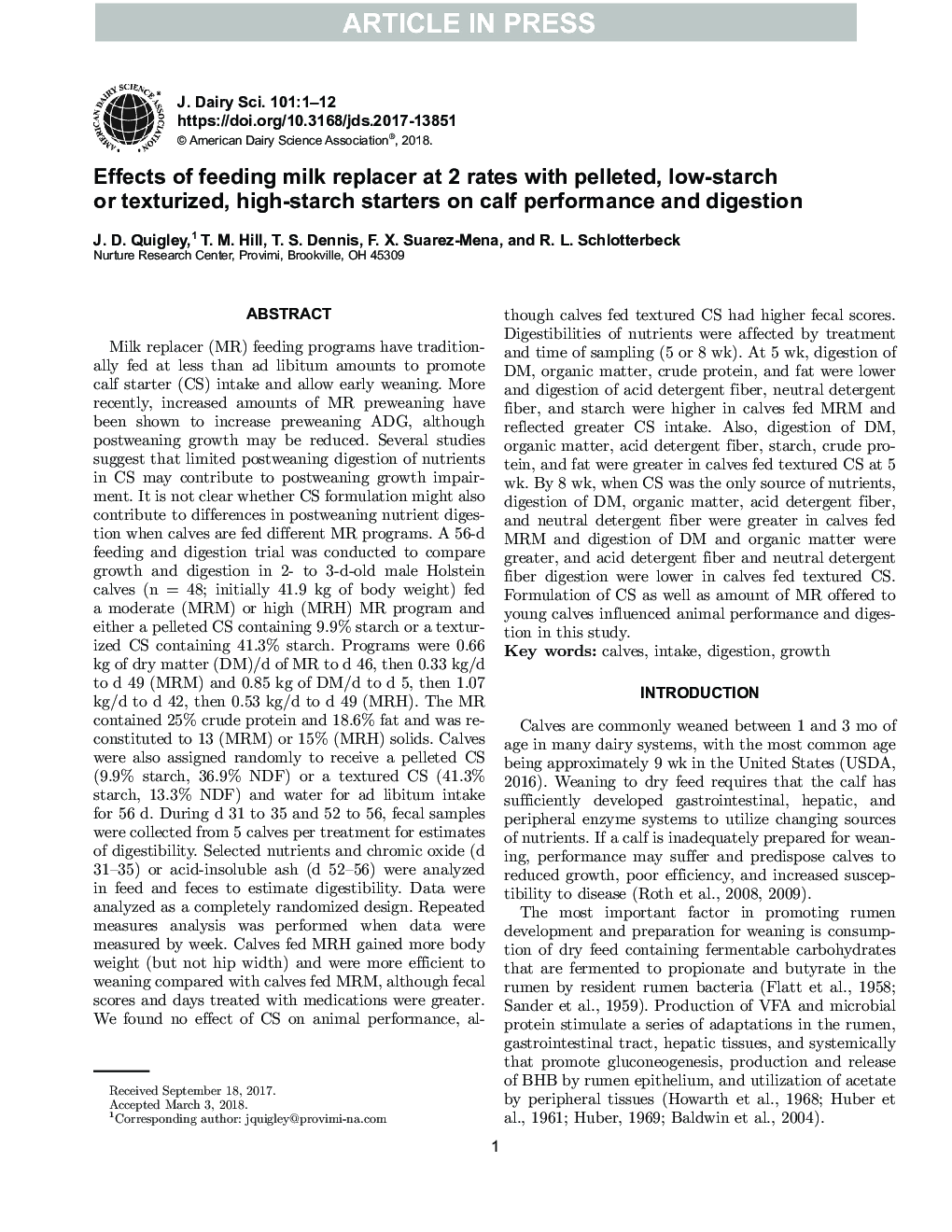| کد مقاله | کد نشریه | سال انتشار | مقاله انگلیسی | نسخه تمام متن |
|---|---|---|---|---|
| 8500958 | 1553838 | 2018 | 12 صفحه PDF | دانلود رایگان |
عنوان انگلیسی مقاله ISI
Effects of feeding milk replacer at 2 rates with pelleted, low-starch or texturized, high-starch starters on calf performance and digestion
ترجمه فارسی عنوان
تأثیر تغذیه شیر تغذیه در 2 بار با استفاده از پودرهای خرد شده، کم نشاسته یا بافتنی و نشاسته با عملکرد بالا بر عملکرد گوساله و هضم
دانلود مقاله + سفارش ترجمه
دانلود مقاله ISI انگلیسی
رایگان برای ایرانیان
کلمات کلیدی
گوساله ها، مصرف، هضم، رشد،
موضوعات مرتبط
علوم زیستی و بیوفناوری
علوم کشاورزی و بیولوژیک
علوم دامی و جانورشناسی
چکیده انگلیسی
Milk replacer (MR) feeding programs have traditionally fed at less than ad libitum amounts to promote calf starter (CS) intake and allow early weaning. More recently, increased amounts of MR preweaning have been shown to increase preweaning ADG, although postweaning growth may be reduced. Several studies suggest that limited postweaning digestion of nutrients in CS may contribute to postweaning growth impairment. It is not clear whether CS formulation might also contribute to differences in postweaning nutrient digestion when calves are fed different MR programs. A 56-d feeding and digestion trial was conducted to compare growth and digestion in 2- to 3-d-old male Holstein calves (n = 48; initially 41.9 kg of body weight) fed a moderate (MRM) or high (MRH) MR program and either a pelleted CS containing 9.9% starch or a texturized CS containing 41.3% starch. Programs were 0.66 kg of dry matter (DM)/d of MR to d 46, then 0.33 kg/d to d 49 (MRM) and 0.85 kg of DM/d to d 5, then 1.07 kg/d to d 42, then 0.53 kg/d to d 49 (MRH). The MR contained 25% crude protein and 18.6% fat and was reconstituted to 13 (MRM) or 15% (MRH) solids. Calves were also assigned randomly to receive a pelleted CS (9.9% starch, 36.9% NDF) or a textured CS (41.3% starch, 13.3% NDF) and water for ad libitum intake for 56 d. During d 31 to 35 and 52 to 56, fecal samples were collected from 5 calves per treatment for estimates of digestibility. Selected nutrients and chromic oxide (d 31-35) or acid-insoluble ash (d 52-56) were analyzed in feed and feces to estimate digestibility. Data were analyzed as a completely randomized design. Repeated measures analysis was performed when data were measured by week. Calves fed MRH gained more body weight (but not hip width) and were more efficient to weaning compared with calves fed MRM, although fecal scores and days treated with medications were greater. We found no effect of CS on animal performance, although calves fed textured CS had higher fecal scores. Digestibilities of nutrients were affected by treatment and time of sampling (5 or 8 wk). At 5 wk, digestion of DM, organic matter, crude protein, and fat were lower and digestion of acid detergent fiber, neutral detergent fiber, and starch were higher in calves fed MRM and reflected greater CS intake. Also, digestion of DM, organic matter, acid detergent fiber, starch, crude protein, and fat were greater in calves fed textured CS at 5 wk. By 8 wk, when CS was the only source of nutrients, digestion of DM, organic matter, acid detergent fiber, and neutral detergent fiber were greater in calves fed MRM and digestion of DM and organic matter were greater, and acid detergent fiber and neutral detergent fiber digestion were lower in calves fed textured CS. Formulation of CS as well as amount of MR offered to young calves influenced animal performance and digestion in this study.
ناشر
Database: Elsevier - ScienceDirect (ساینس دایرکت)
Journal: Journal of Dairy Science - Volume 101, Issue 7, July 2018, Pages 5937-5948
Journal: Journal of Dairy Science - Volume 101, Issue 7, July 2018, Pages 5937-5948
نویسندگان
J.D. Quigley, T.M. Hill, T.S. Dennis, F.X. Suarez-Mena, R.L. Schlotterbeck,
